A Short-Term Wind Power Forecasting Approach Based on Model Configuration Optimization via Prequential-Cross Cooperative Validation Estimation
Abstract
1. Introduction
2. Proposed Approach
2.1. Data Preprocessing Based on Box-Plot Local Detection–Correction
2.1.1. Spatial–Temporal Optimal-Weighted Fuzzy Clustering
2.1.2. Box-Plot Local Detection–Correction
2.2. Model Configuration Optimization Based on Prequential-Cross Cooperative Validation Estimation
2.2.1. Prequential-Cross Cooperative Validation Estimation
2.2.2. CNN-BiLSTM-MHA
3. Application
3.1. Datasets Description
3.2. Evaluation Indices
4. Experiments and Analysis
4.1. Effectiveness Analysis of Spatial–Temporal Optimal-Weighted Fuzzy Clustering
4.2. Effectiveness Analysis of Box-Plot Local Detection–Correction
4.3. Effectiveness Analysis of Prequential-Cross Cooperative Validation Estimation
4.4. Ablation Analysis of Proposed Approach
4.5. Performance Comparison of Different Approaches
5. Conclusions
Author Contributions
Funding
Institutional Review Board Statement
Informed Consent Statement
Data Availability Statement
Conflicts of Interest
Appendix A
| Main Component | Main Hyperparameter |
|---|---|
| 1st LSTM | HN = 16 and IL = 0.035 |
| 2nd LSTM | HN = 16 and IL = 0.05 |
| 3rd LSTM | HN = 32 and IL = 0.05 |
| 4th LSTM | HN = 32 and IL = 0.05 |
| 5th LSTM | HN = 32 and IL = 0.065 |
| 6th LSTM | HN = 48 and IL = 0.065 |
| Monarch butterfly optimization | PS = 20, MG = 100, MR = 0.4, and MP = 1.2 |
| CVE | N = 10 |
| Main Component | Main Hyperparameter |
|---|---|
| TCN-LSTM-SA | FS = 32, CK = 3, DF = 2, HN = 48, and IL = 0.05 |
| Improved coot optimization | PS = 20, MG = 100, LD = 0.2, and CC = 5 |
| Main Component | Main Hyperparameter |
|---|---|
| CNN-LSTM | FS = 32, CK = 3, HN = 32, and IL = 0.065 |
| Coati optimization | PS = 20 and MG = 100 |
| Main Component | Main Hyperparameter |
|---|---|
| BLDC | K = 4 and D = 2 |
| CNN-BiLSTM-MHA | FS = 32, CK = 3, HN = 48, IL = 0.05, AH = 2, and KC = 2 |
| Dual fitness particle swarm optimization | PS = 20, MG = 100, and IW = 0.9 |
| PCCVE | N = 5 |
References
- Kanagarathinam, K.; Aruna, S.K.; Ravivarman, S.; Safran, M.; Alfarhood, S.; Alrajhi, W. Enhancing sustainable urban energy management through short-term wind power forecasting using lstm neural network. Sustainability 2023, 15, 13424. [Google Scholar] [CrossRef]
- Guo, Z.; Wei, F.; Qi, W.; Han, Q.; Liu, H.; Feng, X.; Zhang, M. A time series prediction model for wind power based on the empirical mode decomposition–convolutional neural network–three-dimensional gated neural network. Sustainability 2024, 16, 3474. [Google Scholar] [CrossRef]
- World Wind Energy Association. WWEA Annual Report 2024: A Challenging Year for Windpower. Available online: https://wwindea.org/GlobalStatistics (accessed on 23 April 2025).
- Mao, J.; Zhao, J.; Zhang, H.; Gu, B. A Novel Hybrid Deep Learning Model for Day-Ahead Wind Power Interval Forecasting. Sustainability 2025, 17, 3239. [Google Scholar] [CrossRef]
- Song, Y.; Tang, D.; Yu, J.; Yu, Z.; Li, X. Short-term forecasting based on graph convolution networks and multiresolution convolution neural networks for wind power. IEEE Trans. Ind. Inform. 2023, 19, 1691–1702. [Google Scholar] [CrossRef]
- Wang, H.; Xue, W.; Liu, Y.; Peng, J.; Jiang, H. Probabilistic wind power forecasting based on spiking neural network. Energy 2020, 196, 117072. [Google Scholar] [CrossRef]
- Pan, C.; Wen, S.; Zhu, M.; Ye, H.; Ma, J.; Jiang, S. Hedge backpropagation based online LSTM architecture for ultra-short-term wind power forecasting. IEEE Trans. Power Syst. 2024, 39, 4179–4192. [Google Scholar] [CrossRef]
- Jonkers, J.; Avendano, D.N.; Van Wallendael, G.; Van Hoecke, S. A novel day-ahead regional and probabilistic wind power forecasting framework using deep CNNs and conformalized regression forests. Appl. Energy 2024, 361, 122900. [Google Scholar] [CrossRef]
- Al-Yahyai, S.; Charabi, Y.; Gastli, A. Review of the use of numerical weather prediction (NWP) models for wind energy assessment. Renew. Sust. Energ. Rev. 2010, 14, 3192–3198. [Google Scholar] [CrossRef]
- Zhang, J.; Yan, J.; Infield, D.; Liu, Y.; Lien, F.S. Short-term forecasting and uncertainty analysis of wind turbine power based on long short-term memory network and Gaussian mixture model. Appl. Energy 2019, 241, 229–244. [Google Scholar] [CrossRef]
- Bikcora, C.; Verheijen, L.; Weiland, S. Density forecasting of daily electricity demand with ARMA-GARCH, CAViaR, and CARE econometric models. Sustain. Energy Grids Netw. 2018, 13, 148–156. [Google Scholar] [CrossRef]
- Yunus, K.; Thiringer, T.; Chen, P. ARIMA-based frequency-decomposed modeling of wind speed time series. IEEE Trans. Power Syst. 2016, 31, 2546–2556. [Google Scholar] [CrossRef]
- Wang, Y.; Zou, R.; Liu, F.; Zhang, L.; Liu, Q. A review of wind speed and wind power forecasting with deep neural networks. Appl. Energy 2021, 304, 117766. [Google Scholar] [CrossRef]
- Shams, M.H.; Niaz, H.; Hashemi, B.; Liu, J.J.; Siano, P.; Anvari-Moghaddam, A. Artificial intelligence-based prediction and analysis of the oversupply of wind and solar energy in power systems. Energy Conv. Manag. 2021, 250, 114892. [Google Scholar] [CrossRef]
- Wolpert, D.H.; Macready, W.G. An efficient method to estimate bagging’s generalization error. Mach. Learn. 1999, 35, 41–55. [Google Scholar] [CrossRef]
- Wang, X.; Luo, D.; Zhao, X.; Sun, Z. Estimates of energy consumption in China using a self-adaptive multi-verse optimizer-based support vector machine with rolling cross-validation. Energy 2018, 152, 539–548. [Google Scholar] [CrossRef]
- Wu, Z.; Xia, X.; Xiao, L.; Liu, Y. Combined model with secondary decomposition-model selection and sample selection for multi-step wind power forecasting. Energy 2020, 261, 114345. [Google Scholar] [CrossRef]
- Lainder, A.D.; Wolfinger, R.D. Forecasting with gradient boosted trees: Augmentation, tuning, and cross-validation strategies: Winning solution to the M5 Uncertainty competition. Int. J. Forecast. 2022, 38, 1426–1433. [Google Scholar] [CrossRef]
- Krawczuk, J.; Łukaszuk, T. The feature selection bias problem in relation to high-dimensional gene data. Artif. Intell. Med. 2016, 66, 63–71. [Google Scholar] [CrossRef] [PubMed]
- Cerqueira, V.; Torgo, L.; Mozetič, I. Evaluating time series forecasting models: An empirical study on performance estimation methods. Mach. Learn. 2020, 109, 1997–2028. [Google Scholar] [CrossRef]
- Bergmeir, C.; Hyndman, R.J.; Koo, B. A note on the validity of cross-validation for evaluating autoregressive time series prediction. Comput. Stat. Data Anal. 2018, 120, 70–83. [Google Scholar] [CrossRef]
- Bergmeir, C.; Benítez, J.M. On the use of cross-validation for time series predictor evaluation. Inf. Sci. 2012, 191, 192–213. [Google Scholar] [CrossRef]
- Wang, G.; Jia, R.; Liu, J.; Zhang, H. A hybrid wind power forecasting approach based on Bayesian model averaging and ensemble learning. Renew. Energy 2020, 145, 2426–2434. [Google Scholar] [CrossRef]
- McGill, R.; Tukey, J.W.; Larsen, W.A. Variations of box plots. Am. Stat. 1978, 33, 12–16. [Google Scholar] [CrossRef]
- Smiti, A. A critical overview of outlier detection methods. Comput. Sci. Rev. 2020, 38, 100306. [Google Scholar] [CrossRef]
- Liu, S.; Liu, X.; Lyu, Q.; Li, F. Comprehensive system based on a DNN and LSTM for predicting sinter composition. Appl. Soft Comput. 2020, 95, 106574. [Google Scholar] [CrossRef]
- Fang, P.; Fu, W.; Wang, K.; Xiong, D.; Zhang, K. A compositive architecture coupling outlier correction, EWT, nonlinear Volterra multi-model fusion with multi-objective optimization for short-term wind speed forecasting. Appl. Energy 2022, 307, 118–191. [Google Scholar] [CrossRef]
- Blázquez-García, A.; Conde, A.; Mori, U.; Lozano, J.A. A review on outlier/anomaly detection in time series data. ACM Comput. Surv. 2022, 54, 1–33. [Google Scholar] [CrossRef]
- Angiulli, F.; Fassetti, F. Distance-based outlier queries in data streams: The novel task and algorithms. Data Min. Knowl. Discov. 2010, 20, 290–324. [Google Scholar] [CrossRef]
- Deb, K.; Pratap, A.; Agarwal, S.; Meyarivan, T.A.M.T. A fast and elitist multiobjective genetic algorithm: NSGA-II. IEEE Trans. Evol. Comput. 2002, 6, 182–197. [Google Scholar] [CrossRef]
- Li, Z.; Li, L.; Chen, J.; Wang, D. A multi-head attention mechanism aided hybrid network for identifying batteries’ state of charge. Energy 2024, 286, 129504. [Google Scholar] [CrossRef]
- Rezaei, F.; Safavi, H.R. Sustainable conjunctive water use modeling using dual fitness particle swarm optimization algorithm. Water Resour. Manag. 2022, 36, 989–1006. [Google Scholar] [CrossRef]
- Wang, G.; Jia, L.; Xiao, Q. A hybrid approach based on unequal span segmentation-clustering for short-term wind power forecasting. IEEE Trans. Power Syst. 2023, 39, 203–216. [Google Scholar] [CrossRef]
- Sun, G.; Jiang, C.; Cheng, P.; Liu, Y.; Wang, X.; Fu, Y.; He, Y. Short-term wind power forecasts by a synthetical similar time series data mining method. Renew. Energy 2018, 115, 575–584. [Google Scholar] [CrossRef]
- Xia, J.; Shang, P.; Wang, J.; Shi, W. Permutation and weighted-permutation entropy analysis for the complexity of nonlinear time series. Commun. Nonlinear Sci. Numer. Simul. 2016, 31, 60–68. [Google Scholar] [CrossRef]
- DiCiccio, T.J.; Efron, B. Bootstrap confidence intervals. Stat. Sci. 1996, 11, 189–228. [Google Scholar] [CrossRef]
- Hintze, J.L.; Nelson, R.D. Violin plots: A box plot-density trace synergism. Am. Stat. 1998, 52, 181–184. [Google Scholar] [CrossRef]
- Hossain, M.A.; Gray, E.; Lu, J.; Islam, M.R.; Alam, M.S.; Chakrabortty, R.; Pota, H.R. Optimized forecasting model to improve the accuracy of very short-term wind power prediction. IEEE Trans. Ind. Inform. 2023, 19, 10145–10159. [Google Scholar] [CrossRef]
- He, X.; He, B.; Qin, T.; Lin, C.; Yang, J. Ultra-short-term wind power forecasting based on a dual-channel deep learning model with improved coot optimization algorithm. Energy 2024, 305, 132320. [Google Scholar] [CrossRef]
- Abou Houran, M.; Bukhari, S.M.S.; Zafar, M.H.; Mansoor, M.; Chen, W. COA-CNN-LSTM: Coati optimization algorithm-based hybrid deep learning model for PV/wind power forecasting in smart grid applications. Appl. Energy 2023, 349, 121638. [Google Scholar] [CrossRef]
- Lai, X.; Meng, Z.; Wang, S.; Han, X.; Zhou, L.; Sun, T.; Li, X.; Wang, X.; Ma, Y.; Zheng, Y. Global parametric sensitivity analysis of equivalent circuit model based on Sobol’method for lithium-ion batteries in electric vehicles. J. Clean. Prod. 2021, 294, 126246. [Google Scholar] [CrossRef]

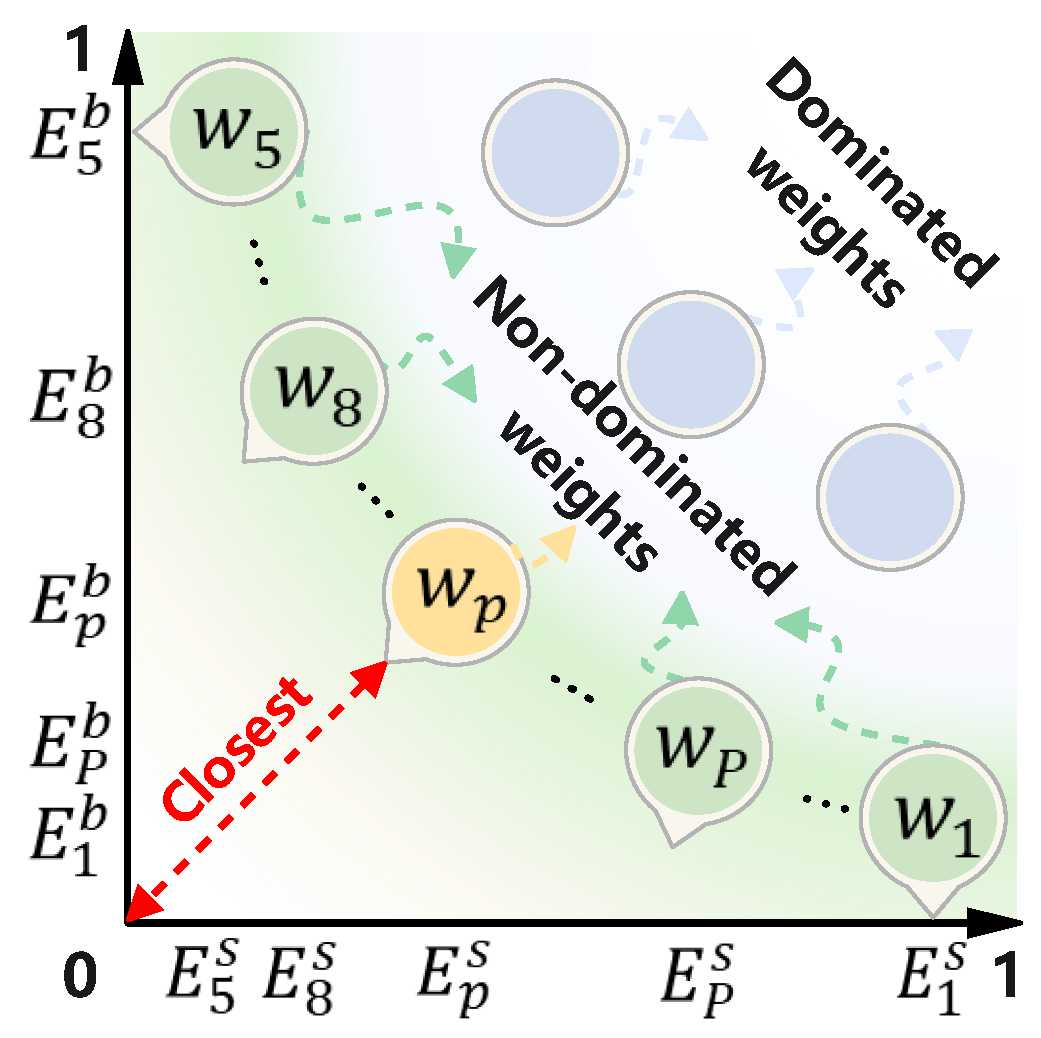


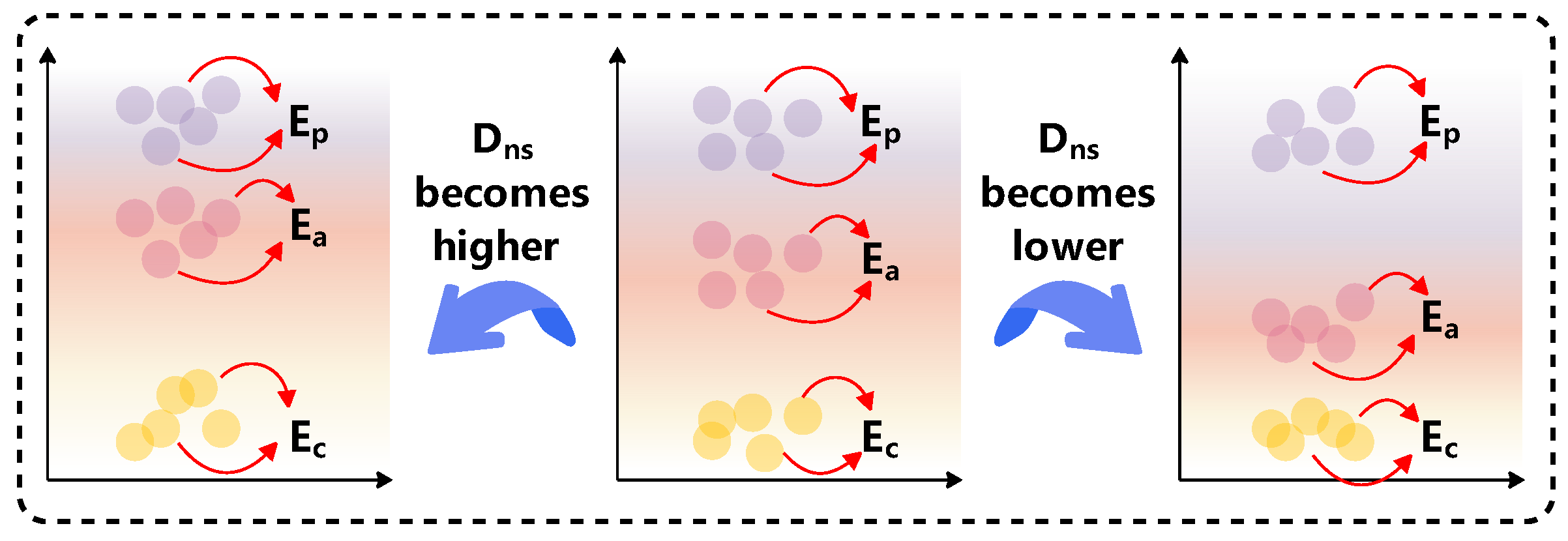
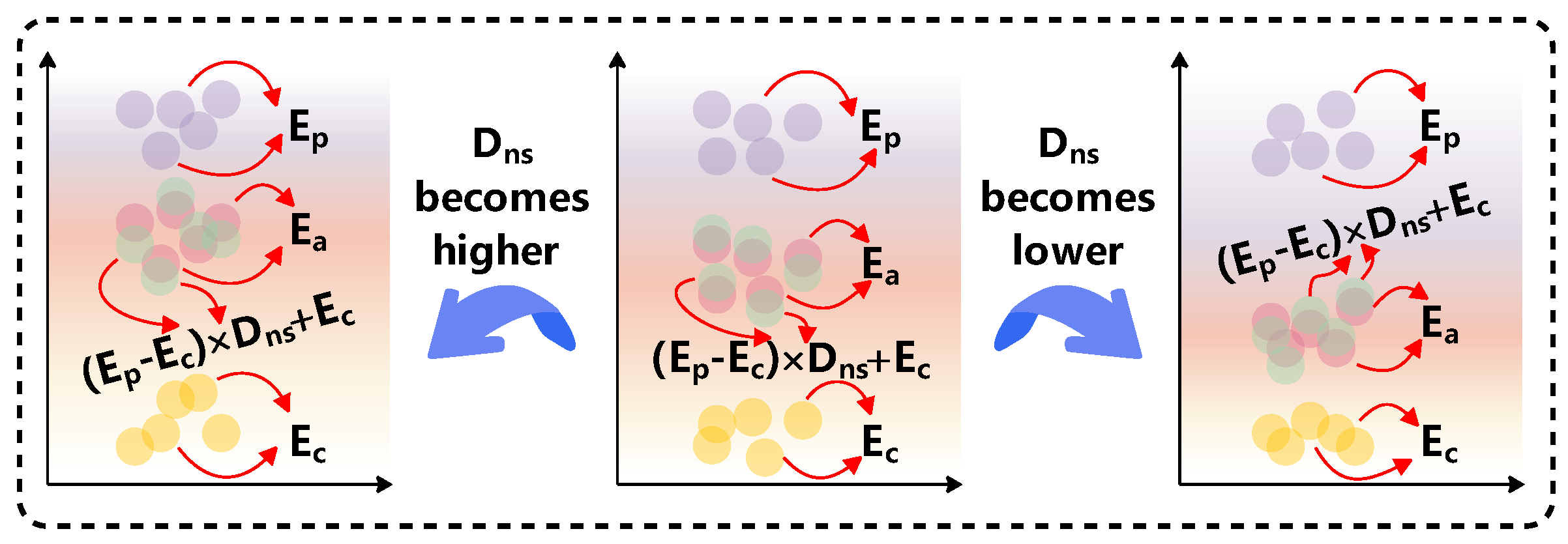
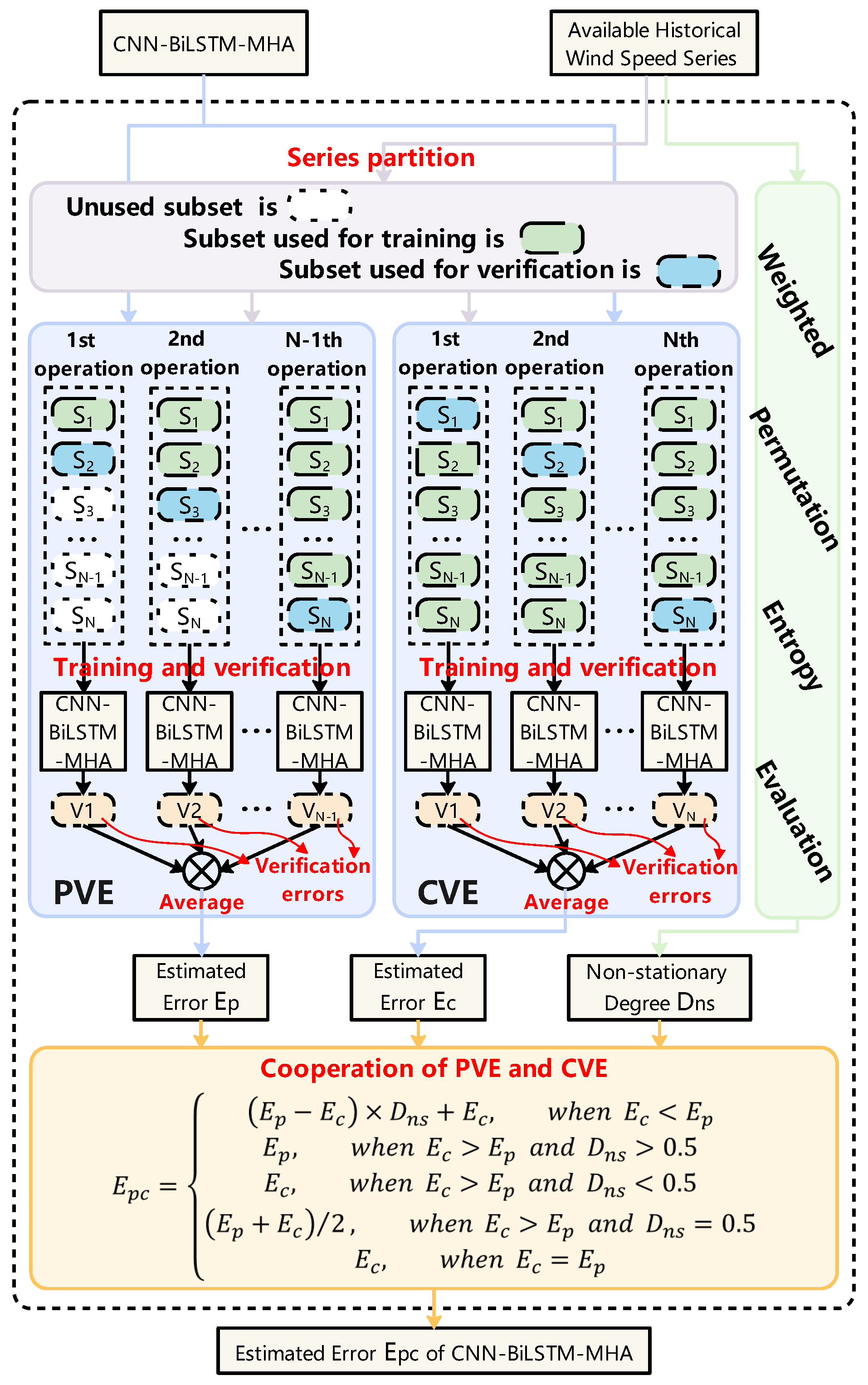

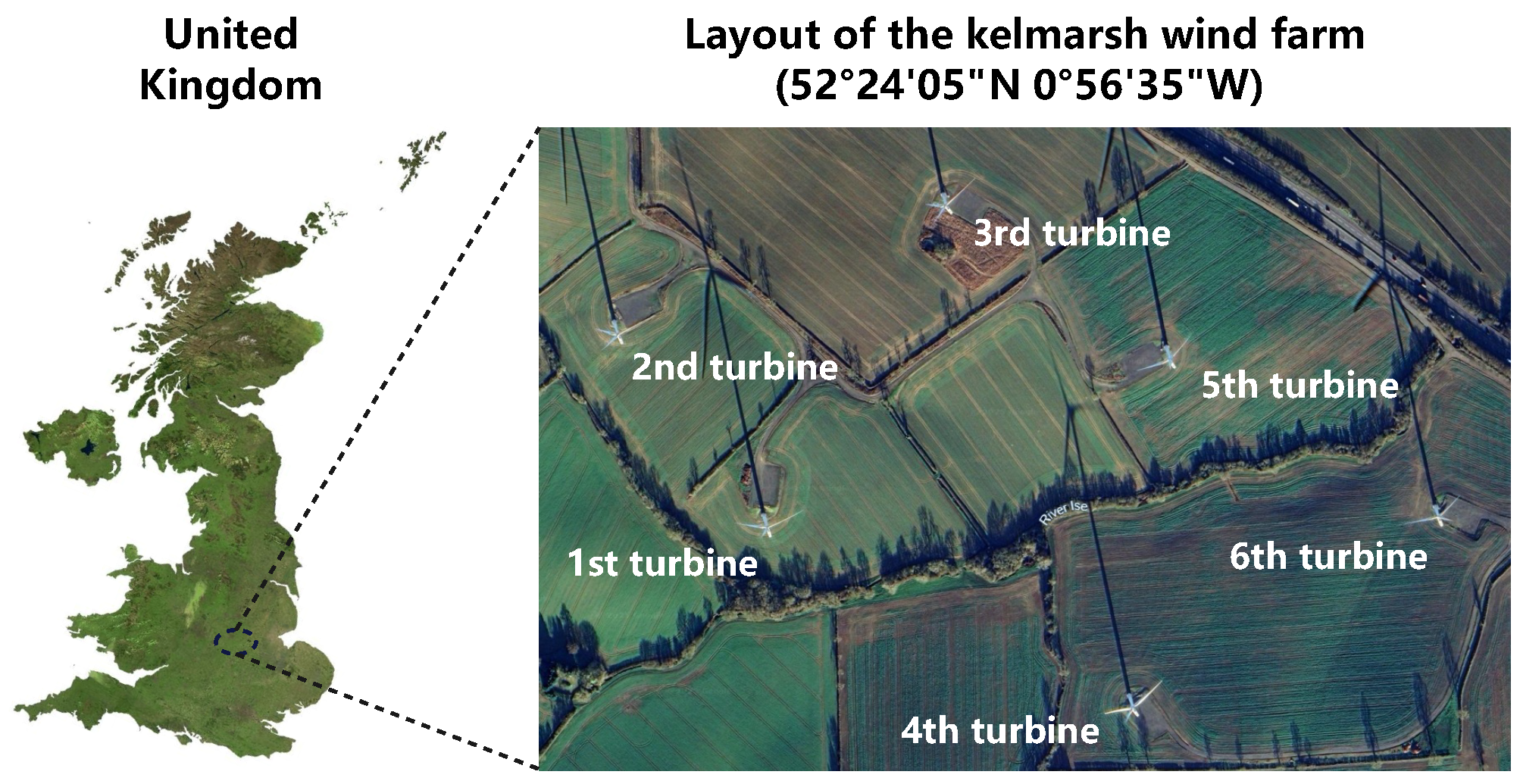


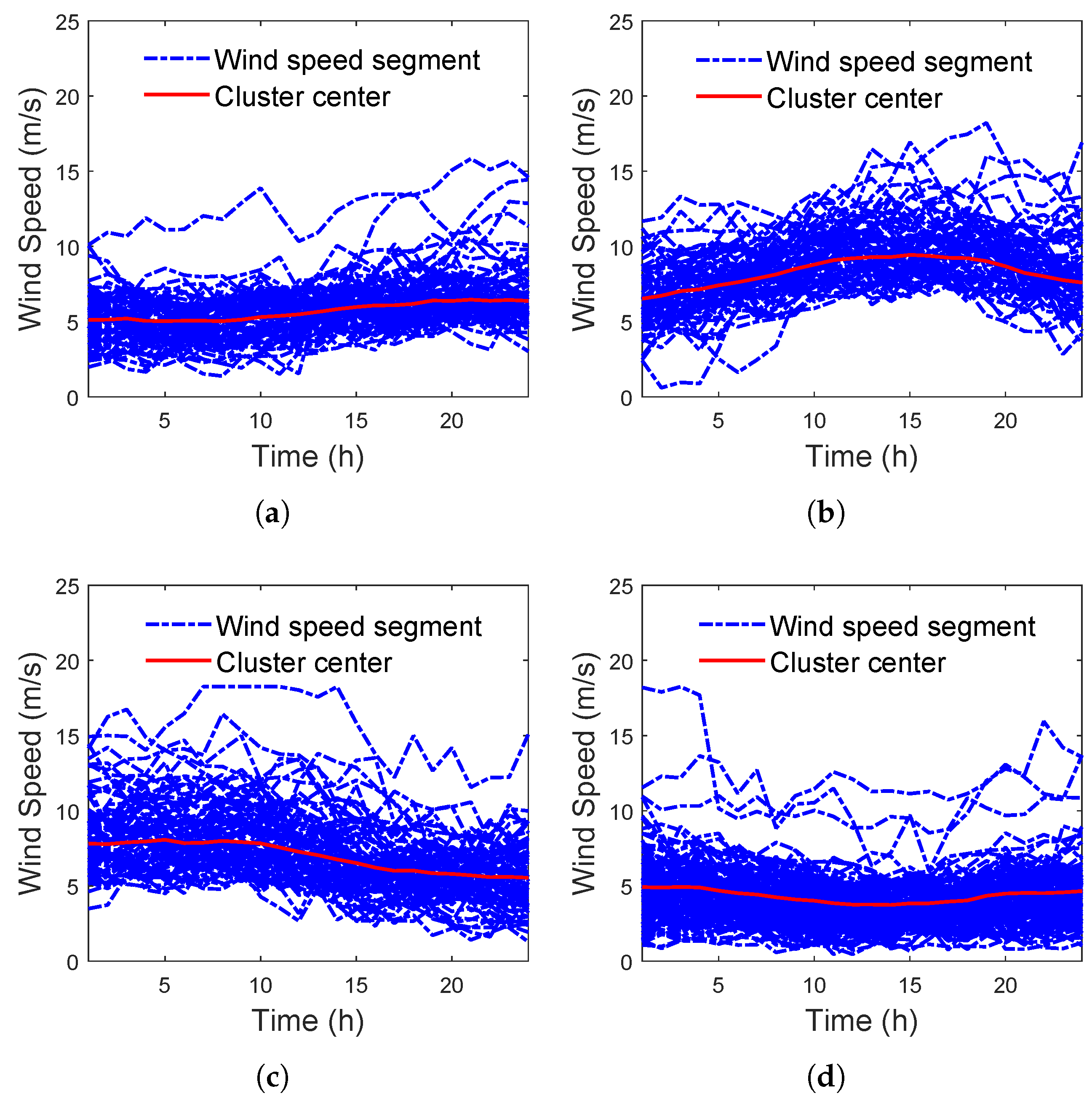



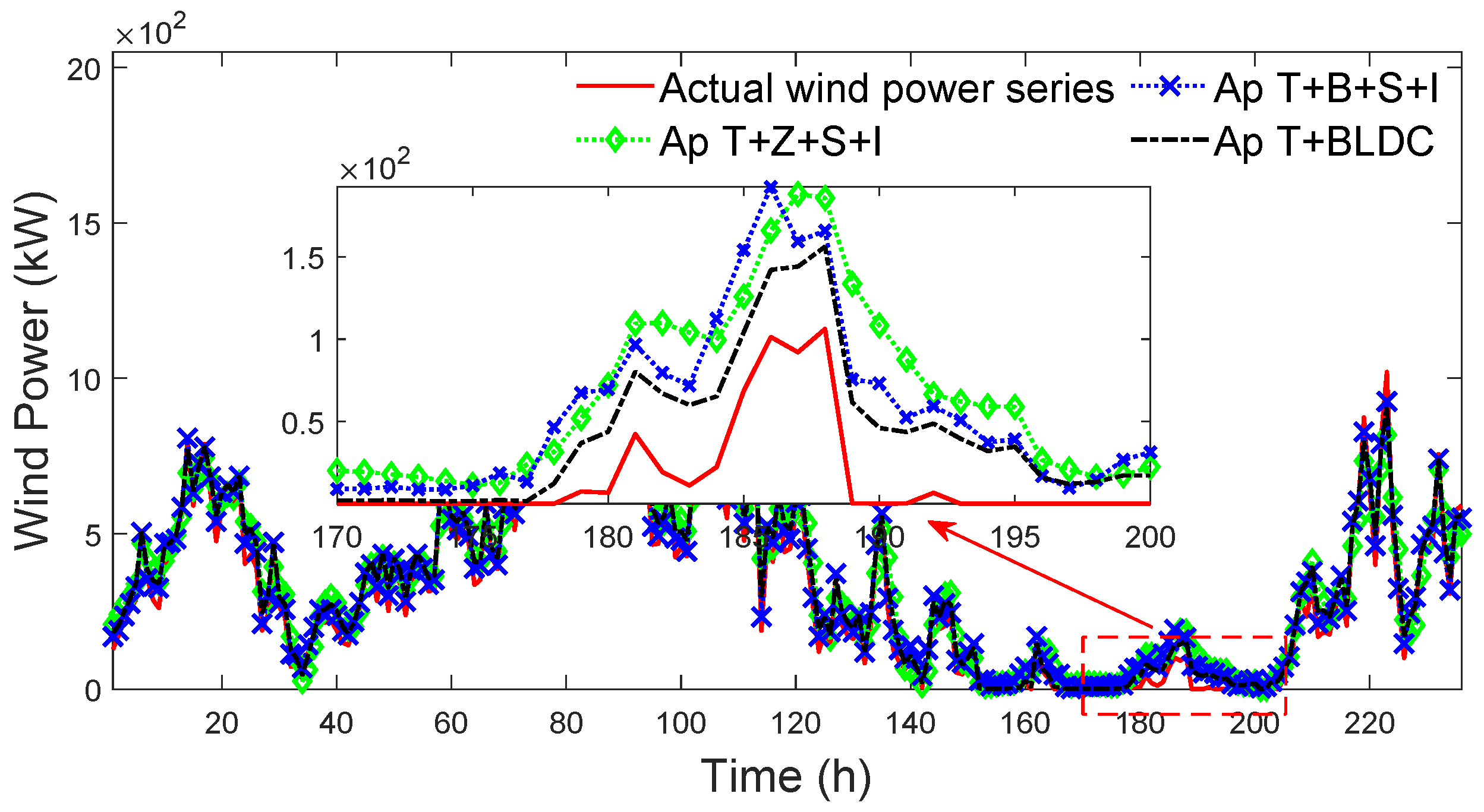


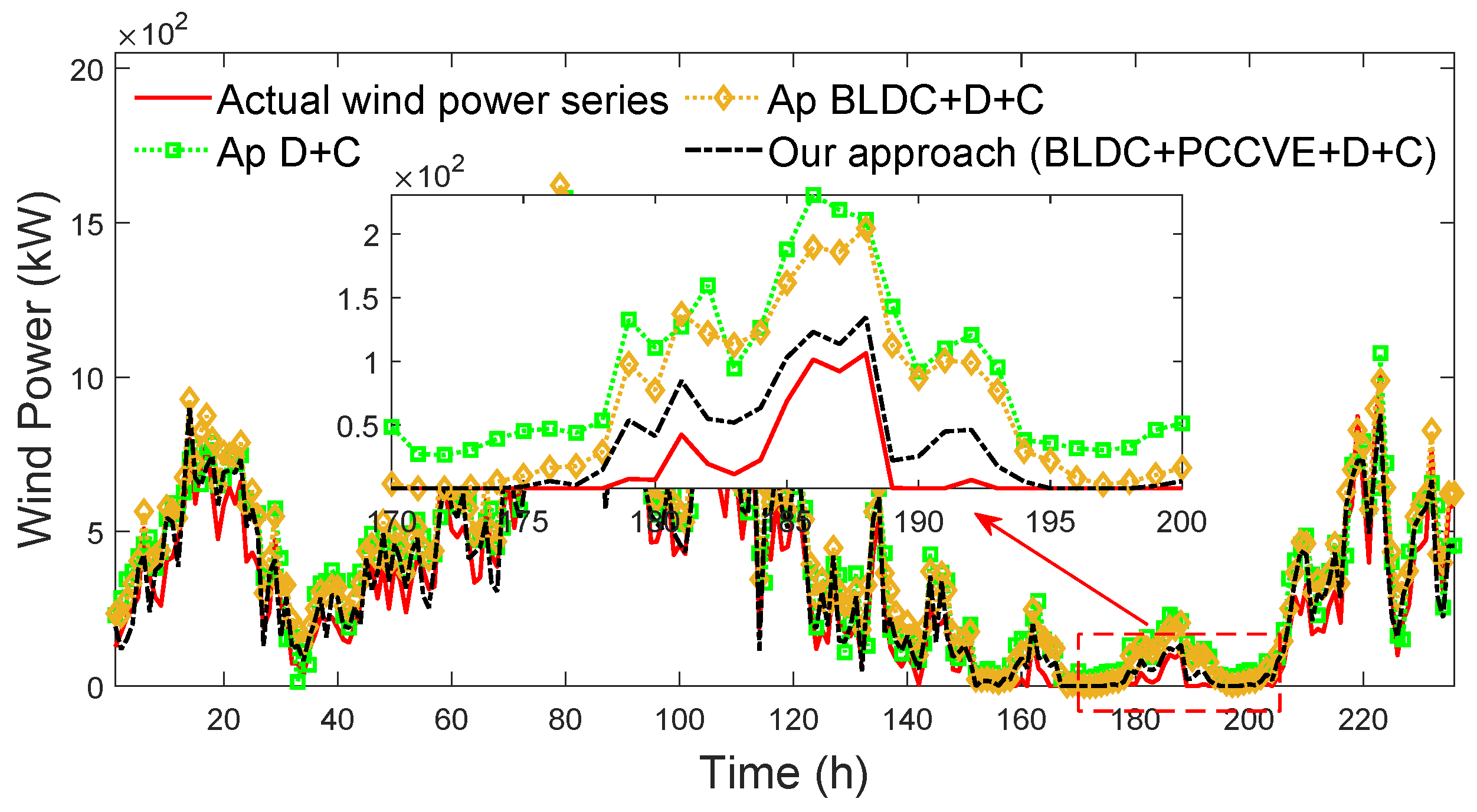


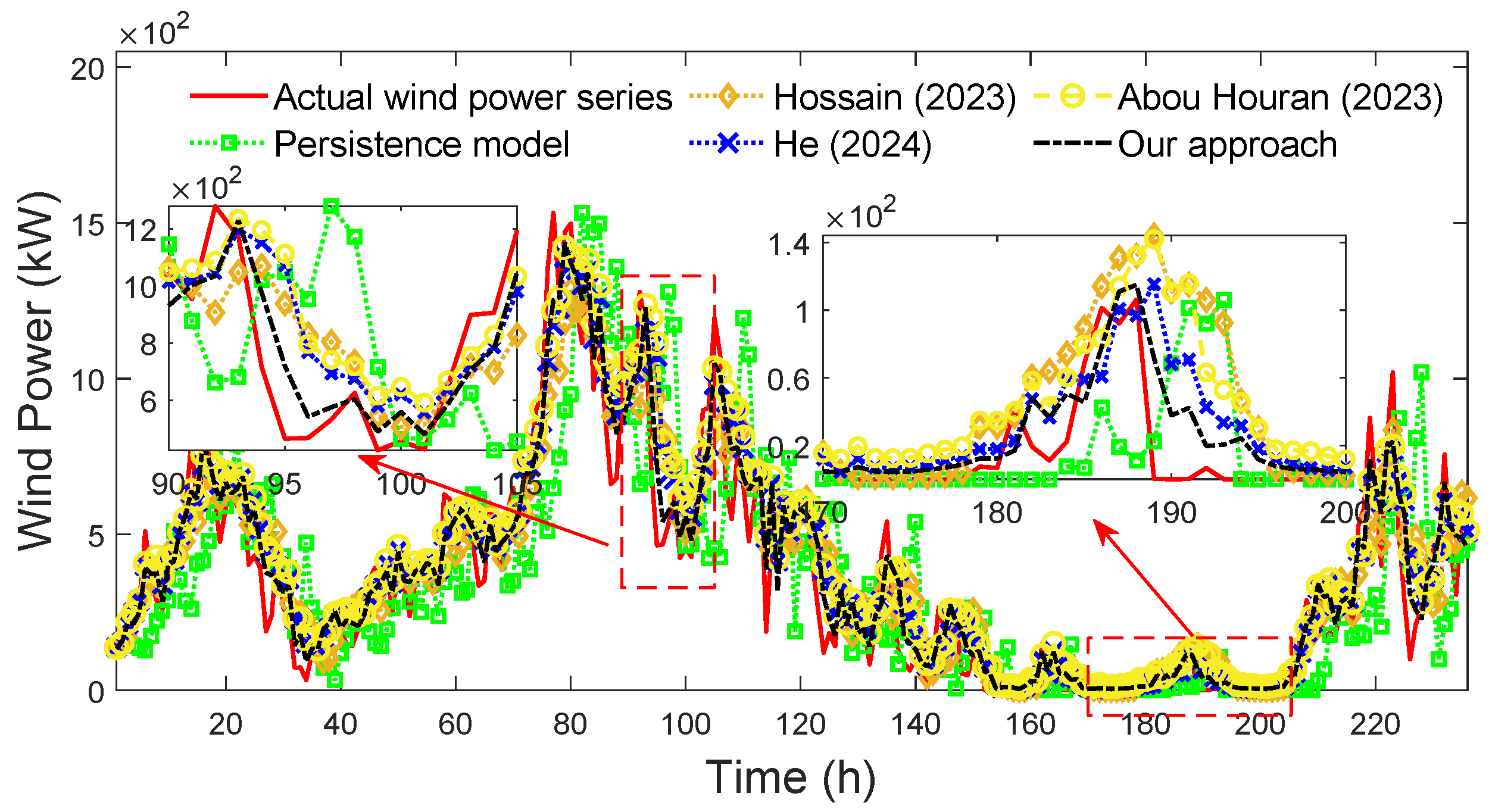
| Approaches | Ap T+Z+S+I | Ap T+B+S+I | Ap T+BLDC |
|---|---|---|---|
| NRMSE | 5.93 | 5.86 | 5.12 |
| NMAE | 5.24 | 5.02 | 4.49 |
| Approaches | Z+S | B+S | BLDC |
|---|---|---|---|
| 2000 | 0.02 s | 0.05 s | 26.21 s |
| 8000 | 0.09 s | 0.18 s | 76.14 s |
| 16,000 | 0.17 s | 0.41 s | 131.26 s |
| ANNs | MLP | ELMAN | LSTM | TCN |
|---|---|---|---|---|
| Dimensions of input () | ✓ | ✓ | ✓ | ✓ |
| Number of hidden neurons (HN) a | ✓ | ✓ | ✓ | |
| Number of filters (FS) | ✓ | |||
| Size of convolution kernel | ✓ | |||
| Momentum factor (MF) | ✓ | ✓ | ||
| Dilation factor (DF) | ✓ | |||
| Initial learn rates (IL) | ✓ | ✓ | ✓ | ✓ |
| Approaches | Ap T+D+PVE | Ap T+D+CVE | Ap T+D+PCCVE |
|---|---|---|---|
| NRMSE | 5.27 | 4.86 | 4.32 |
| NMAE | 4.32 | 4.02 | 3.78 |
| Approaches | Ap D+C | Ap BLDC+D+C | Our Approach (BLDC+PCCVE+D+C) |
|---|---|---|---|
| NRMSE | 6.16 | 5.65 | 3.74 |
| NMAE | 5.44 | 5.10 | 3.25 |
| Runtime | 1223 | 1355 | 7467 |
| Approaches | Ap [38] (17 Main Hyperparameters) | Ap [39] (9 Main Hyperparameters) | Ap [40] (6 Main Hyperparameters) | Our Approach (12 Main Hyperparameters) |
|---|---|---|---|---|
| Data preprocessing | Traditional box-plot elimination a | Traditional box-plot detection–correction | Traditional box-plot elimination a | Traditional box-plot detection–correction, BLDC (2 main hyperparameters K and D) b |
| Model forecasting | 6 LSTMs (12 main hyperparameters include 6 pairs of HN and IL) c | TCN-LSTM-SA (5 main hyperparameters including FS, CK, DF, HN, and IL) c,d,e | CNN-LSTM (4 main hyperparameters including FS, CK, HN, and IL) c, d | CNN-BiLSTM-MHA (6 main hyperparameters including FS, CK, HN, IL, AH, and KC) c,d,f |
| Model configuration optimization | Monarch butterfly optimization (4 main hyperparameters including PS, MG, MR, and MP) g,h, CVE (1 main hyperparameter N) k | Improved coot optimization (4 main hyperparameters including PS, MG, LD, and CC) g,i | Coati optimization (2 main hyperparameters including PS and MG) g | Dual fitness particle swarm optimization (3 main hyperparameters including PS, MG, and IW) g,j, PCCVE (1 main hyperparameter N) k |
| Approaches | Persistence Model | Ap [38] | Ap [39] | Ap [40] | Our Approach |
|---|---|---|---|---|---|
| NRMSE | 7.14 | 6.07 | 4.36 | 5.27 | 3.74 |
| NMAE | 4.91 | 4.65 | 3.73 | 4.60 | 3.25 |
| Runtime | - | 16,147 | 1055 | 821 | 7467 |
Disclaimer/Publisher’s Note: The statements, opinions and data contained in all publications are solely those of the individual author(s) and contributor(s) and not of MDPI and/or the editor(s). MDPI and/or the editor(s) disclaim responsibility for any injury to people or property resulting from any ideas, methods, instructions or products referred to in the content. |
© 2025 by the authors. Licensee MDPI, Basel, Switzerland. This article is an open access article distributed under the terms and conditions of the Creative Commons Attribution (CC BY) license (https://creativecommons.org/licenses/by/4.0/).
Share and Cite
Jia, L.; Wang, G.; Pang, X. A Short-Term Wind Power Forecasting Approach Based on Model Configuration Optimization via Prequential-Cross Cooperative Validation Estimation. Sustainability 2025, 17, 9929. https://doi.org/10.3390/su17229929
Jia L, Wang G, Pang X. A Short-Term Wind Power Forecasting Approach Based on Model Configuration Optimization via Prequential-Cross Cooperative Validation Estimation. Sustainability. 2025; 17(22):9929. https://doi.org/10.3390/su17229929
Chicago/Turabian StyleJia, Liang, Gang Wang, and Xinyu Pang. 2025. "A Short-Term Wind Power Forecasting Approach Based on Model Configuration Optimization via Prequential-Cross Cooperative Validation Estimation" Sustainability 17, no. 22: 9929. https://doi.org/10.3390/su17229929
APA StyleJia, L., Wang, G., & Pang, X. (2025). A Short-Term Wind Power Forecasting Approach Based on Model Configuration Optimization via Prequential-Cross Cooperative Validation Estimation. Sustainability, 17(22), 9929. https://doi.org/10.3390/su17229929






